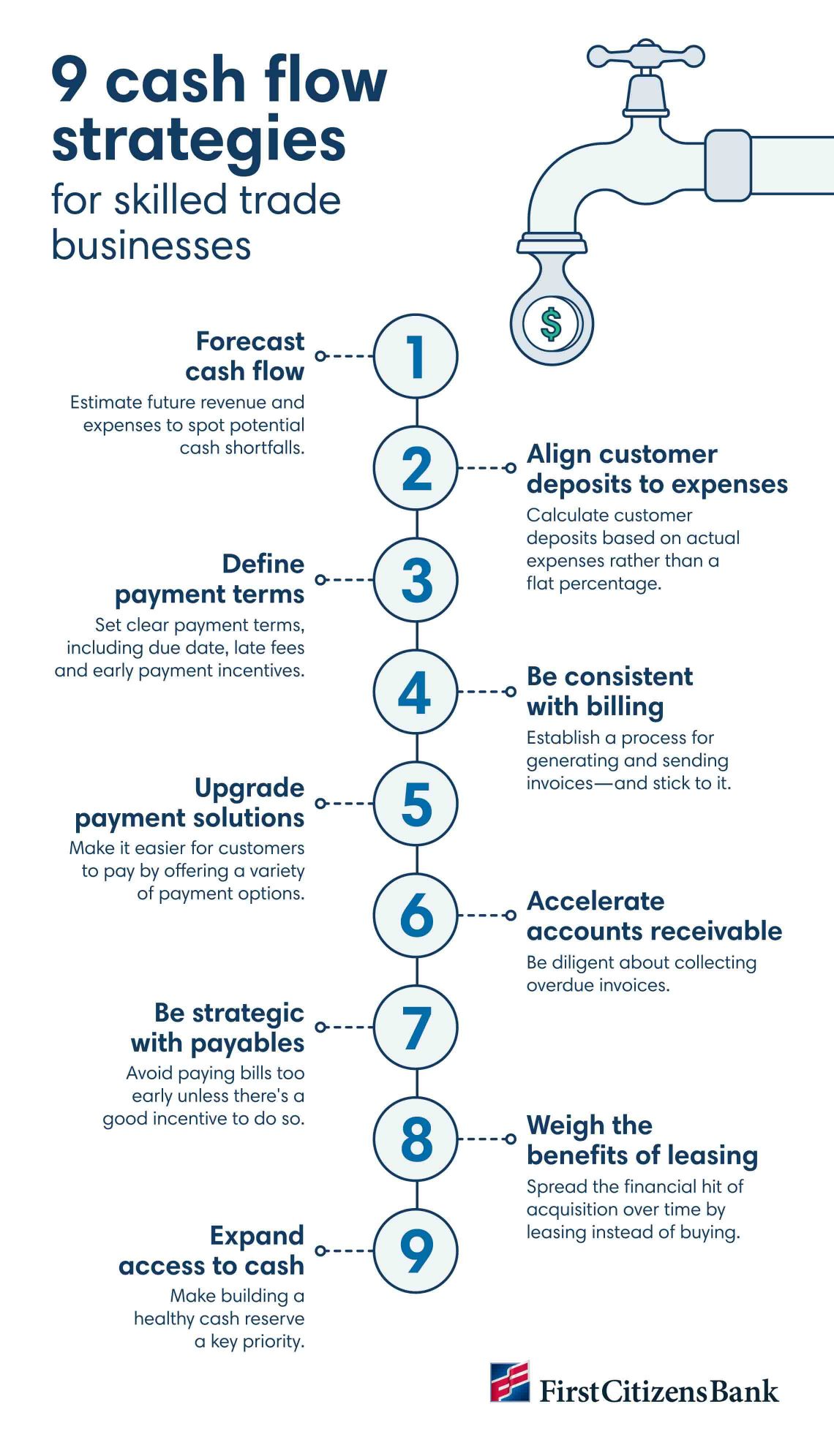Guide to Small Business Cash Flow Management for Skilled Trades
While cash flow is the lifeblood of any business, skilled trade businesses face a unique set of cash requirements—from paying up front for parts and materials to managing fleet operating costs.

If you're running a skilled trade business, getting a better handle on how cash flows work not only boosts day-to-day operations but may also determine your company's survival. The good news is you have far more control over cash flow than you might think.
Why is cash flow management important?
In an industry known for tight margins and high-volume receivables, even profitable skilled trade businesses may struggle to maintain adequate cash balances. In fact, negative cash flow is the primary reason companies in this industry become insolvent, according to Plumbing & Mechanical magazine. For this reason, taking specific steps to improve cash flow management may be key to ensuring your business's long-term health.
Having adequate cash flow also allows you to make timely payments to vendors and subcontractors, which helps nurture and preserve important business relationships. Finally, good small business cash flow management may help ensure that you have the necessary funds to purchase or maintain essential parts and tools without tapping into personal funds.
Factors affecting cash flow
Factors that can impact a business's cash flow include unexpected growth, rising costs, decreasing sales, low cash reserves and a lack of access to low-cost financing. Seasonality is another common issue in skilled trades, as are extended collection cycles.

How to improve cash flow
While there are unique factors that can make it a challenge, these small business cash flow management strategies may help you combat some common stressors.
Forecast cash flow
Conventional wisdom says you can't fix what you don't measure. Calculating your projected cash flow may make it easier for you to spot—and proactively resolve—potential concerns. How far into the future the forecast extends will vary. Landscape architects might prefer a long-term lens to ensure their business is able to withstand seasonal slowdowns, while plumbers and electricians might need a quarterly forecast.
Align customer deposits to your expenses
Instead of relying on a flat percentage as a project deposit, calculate the cash requirements from the time of the deposit to your next expected payment. This approach may help ensure that customer deposits will sufficiently cover your expenses during that billing cycle.
Define payment terms
Review contracts to ensure they detail conditions like payment deadlines, late fees, and penalties and available payment options. If late payments are a persistent challenge for your business, you might also consider including early payment incentives. Offering a modest discount may entice customers to speed up their payments, which may positively impact cash flow.
Be consistent with billing
Establish a regular schedule for generating and sending invoices to clients, and standardize client communications to minimize potential confusion around due dates or late fees. Likewise, be sure to set up internal systems so any change orders are processed and invoiced promptly.
Upgrade payment solutions
Customers are more likely to pay on time when invoices are easier to pay. Review the payment options you offer clients. Are there a variety of choices available to suit their preferences and needs?
Peer-to-peer payment apps or even cash may seem workable when your business is just getting started. As the business grows, however, customers will expect more robust and secure ways to pay.
A point-of-sale solution may allow your team to accept payments while in the field. If you accept personal checks, remote deposit capture may enable swift and secure deposits without having to make a separate trip to the bank.
Accelerate accounts receivable
If you aren't already tracking how long it takes on average for customers to pay your invoices, consider this your rallying cry to start. For skilled trade businesses in particular, lengthy payment delays may create significant cash flow shortfalls.
To accelerate payments while lightening the administrative burden, set up automated invoice reminders and offer customers the ability to pay invoices electronically. It's also a good idea to regularly review outstanding invoices and identify any accounts that might warrant further collections activity.
Be strategic with payables
Paying vendors on time is necessary, but paying too early may hinder your cash flow. Carefully review the payment terms for your go-to partners to weigh the pros and cons of any early payment incentives. In some cases, it may make good financial sense to delay your payments until invoices are due.
Weigh the benefits of leasing
Leasing equipment tends to be more costly than buying outright, at least in the long run. The drawback, of course, is that a large purchase may require you to invest a significant amount of cash up front—cash your business may need to maintain day-to-day operations.
Leasing commercial equipment, on the other hand, typically allows you to spread that financial hit into smaller increments paid over time. This has a much smaller impact on your cash flow and the overall financial health of your growing business. Capital leases with an option to transfer ownership at the end—often at a bargain price—may further reduce risk.
Expand access to cash
When cash flow is tight, financing options like credit cards, lines of credit and working capital loans may help you keep operations humming.
However, building up cash reserves should remain a key priority. This way, you can avoid having to borrow constantly in order to keep your business afloat. The right amount of cash reserves may serve as a safety net, particularly for skilled trades that are affected by factors like seasonality.
The bottom line
It's essential to weigh your cash management solution options carefully before making a decision. You ultimately want to streamline payables and receivables while reducing your business's administrative burden, which makes finding the right solution for your situation paramount.

